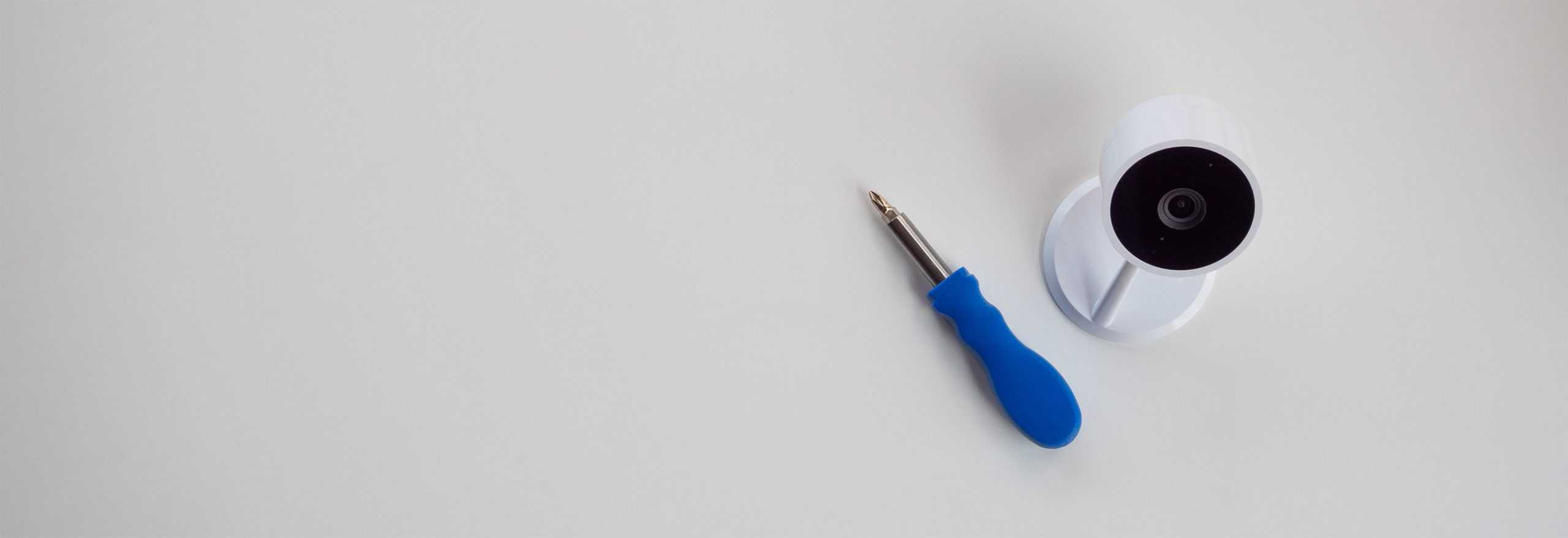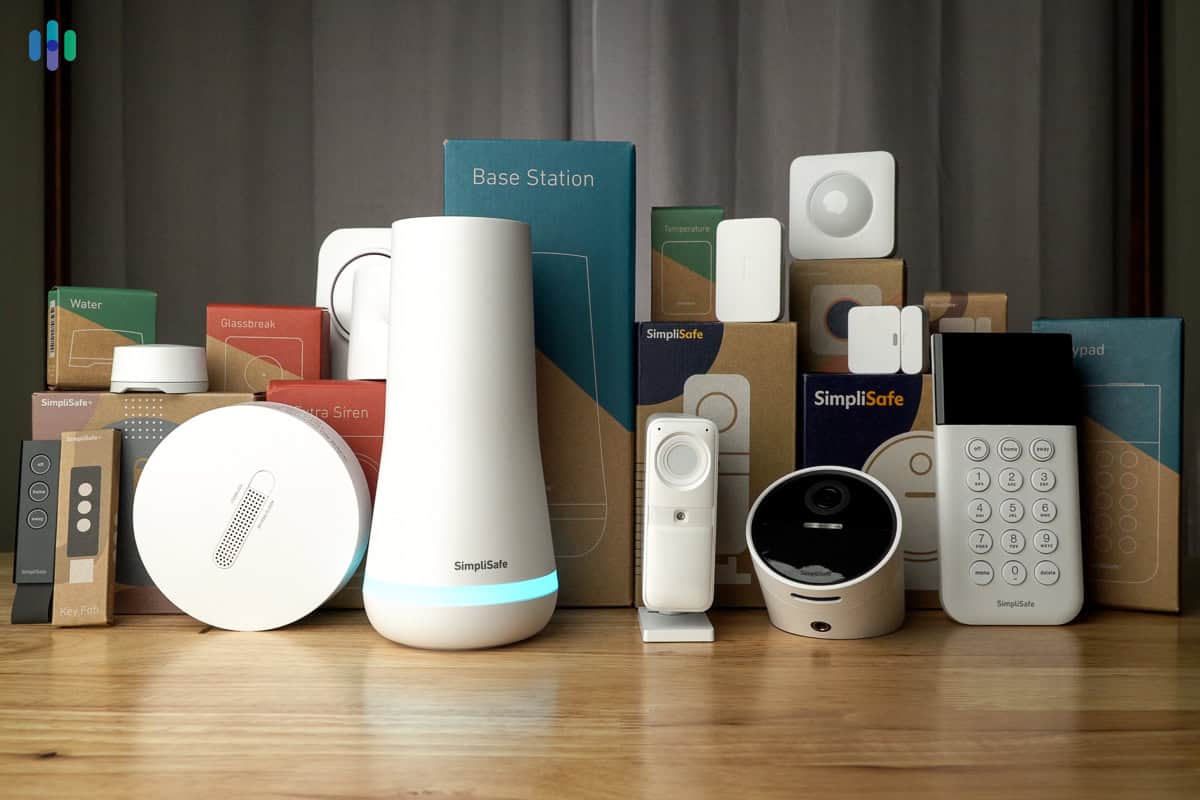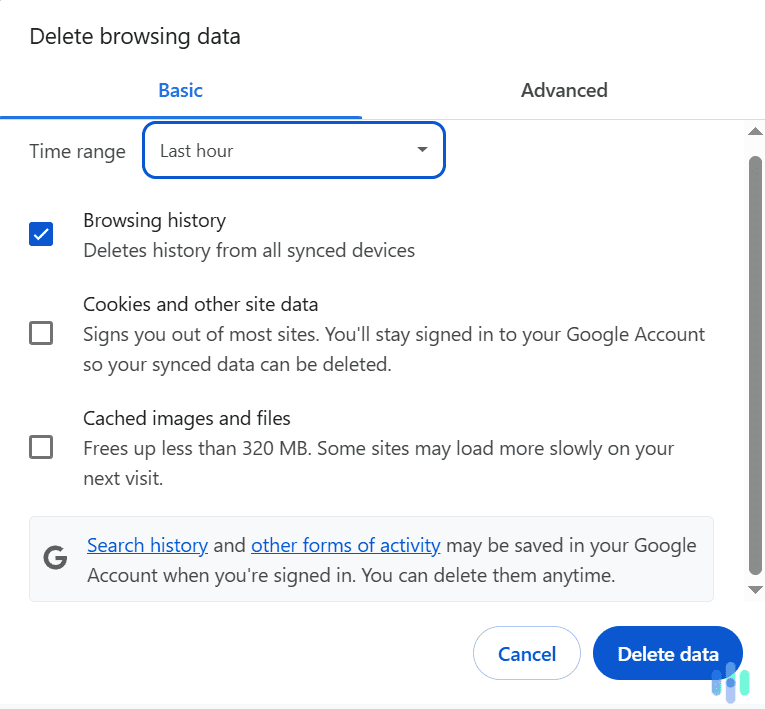Glass break sensors are ingenious little devices that do just what their name promises. They alert you if someone tries to break the glass in one of your home’s windows or doors. In doing so, glass-break detectors provide an important, additional layer of security to your home.
But, setting them up takes a bit of thought. You see, there’s two different kinds of glass break sensors and each one needs a unique set up. We’ve successfully used dozens of glass break sensors so we’re going to go through everything we’ve learned about how they work, how to install them, and how to maintain them. Let’s get started.
Do All Security Systems Have Glass Break Detectors?
As ingenious and useful glass sensors may be, not all security systems offer the device. That’s why we factor in the availability of glass break sensors — as well as other equipment options — when rating security systems. Case in point: The best security systems of 2023 all offer glass break sensors and a wide variety of security equipment. See those options here:
How Does a Glass-Break Detector Work?
Glass-break detectors are designed to let you know if glass breaks in your home. That means if a thief tries to break in through a window or a sliding glass door, you know it immediately. These sensors have a limited range. Depending on which type you choose, you may need one per room or even one per window.
However, if someone tries to break in, you’ll get an alert on your phone, no matter where in the world you may be. You can set glass-break sensors up to trigger video recording. And if your system includes home monitoring, you can count on your security company to alert emergency services if your detector goes off.
There are two basic types of glass-break sensors: acoustic and shock.
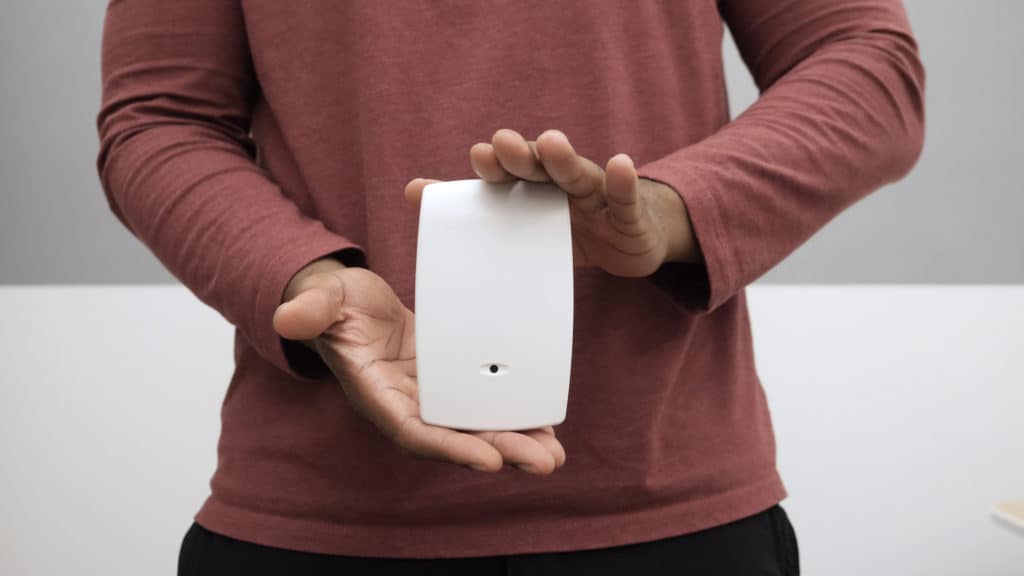
Acoustic Glass-Break Sensors
This type of sensor works by listening to sound. As a result, you only need one sensor in a small room. Simply place the sensor in a central location, and it will listen for sound from any of the windows.
Acoustic glass-break detectors use narrowband microphones connected to electronic circuitry. The most simple of these devices are tuned to the typical frequencies glass emits when it breaks.
More complicated sensors use a two-step process. First, these sensors “wake up” if the sound amplitude reaches a particular level. Then, the sensors analyze the sound, looking for statistical similarities to various examples of breaking glass. If a match is close enough, the detector sends you an alert.1 This two-step process extends the battery life of the sensor since it lets the sensor go into a sleep mode.
Shock Glass-Break Sensors
In contrast to acoustic glass-break detectors, you place shock glass-break detectors directly on the glass of a window or door. Shock glass-break detectors aren’t listening for sound, but instead are “feeling” for vibrations. Each has an electrical wire which you attach to the glass. Any movement of the glass moves the wire, which sets off the alarm.2 That means they can notify you if someone bangs on your window without breaking it as well. You’ll just need to adjust the sensitivity level.
Glass-Break Detectors: Pros and Cons
Glass-break detectors add an extra layer of protection to your home, and that’s never a bad thing. Still, before you invest, it’s a good idea to consider both the pros and cons of these devices.
Glass-Break Detector Pros
- Extra security: You may be wondering why you need a glass-break sensor if you’ve already equipped your windows with window sensors. Contact sensors will alert you if someone tries to raise your windows. They aren’t much good if a thief decides to break the glass, though.
- Preemptive alerts: Motion detectors are effective at catching burglars, but by the time a motion detector goes off, a thief is already inside your home. Glass-break sensors can alert you in time to stop thieves in their tracks.
- Night protection: Most homeowners turn off motion detectors when they’re home, especially at night. Glass detectors won’t go off if you get up in the middle of the night for a drink of water. That means you can leave them on, even when the motion detectors are off.
Glass-Break Detector Cons
- False alarms: Almost any home security component can trigger a false alarm under the right circumstances. Slamming a door can cause shock glass-break sensors to go off. Certain frequencies can set off acoustic sensors. Of course, if you drop a glass on the floor, there’s also a good chance the alarm will sound.
- Glass cutters: Acoustic glass-break sensors can’t protect you if a thief uses a glass cutter to enter your home. Glass cutters don’t make enough sound to trigger an acoustic sensor, and a careful thief won’t trigger a shock sensor if they don’t actually break the glass.
- Not always necessary: If your home is small, you may hear breaking glass even without a sensor. In that case, a sensor becomes redundant.
- Additional expense: Obviously, glass-break sensors are an extra expense when you’re securing your home. This is especially true of shock sensors, since you must purchase one for every pane of glass.
FYI: Window contact sensors don’t detect a window break-in if the thief breaks the window’s glass. For that, you need a glass-break sensor.
Do I Need Glass-Break Detectors?
We like to say that everyone needs a home security system. Not everyone needs to invest in glass-break detectors, though. If you live in an apartment on the upper floor, you don’t need to protect your windows. By the same token, if you own a multistory home, you may not need to put glass-break detectors in those upper-story windows.
For everyone else, though, glass-break sensors offer important security for your home. The only real question then is just how many you need. If you’re purchasing acoustic sensors, one sensor per ground-floor room might be enough, depending on the size of the room. If you’re purchasing shock detectors, you need to buy one for each ground floor window and any glass doors.
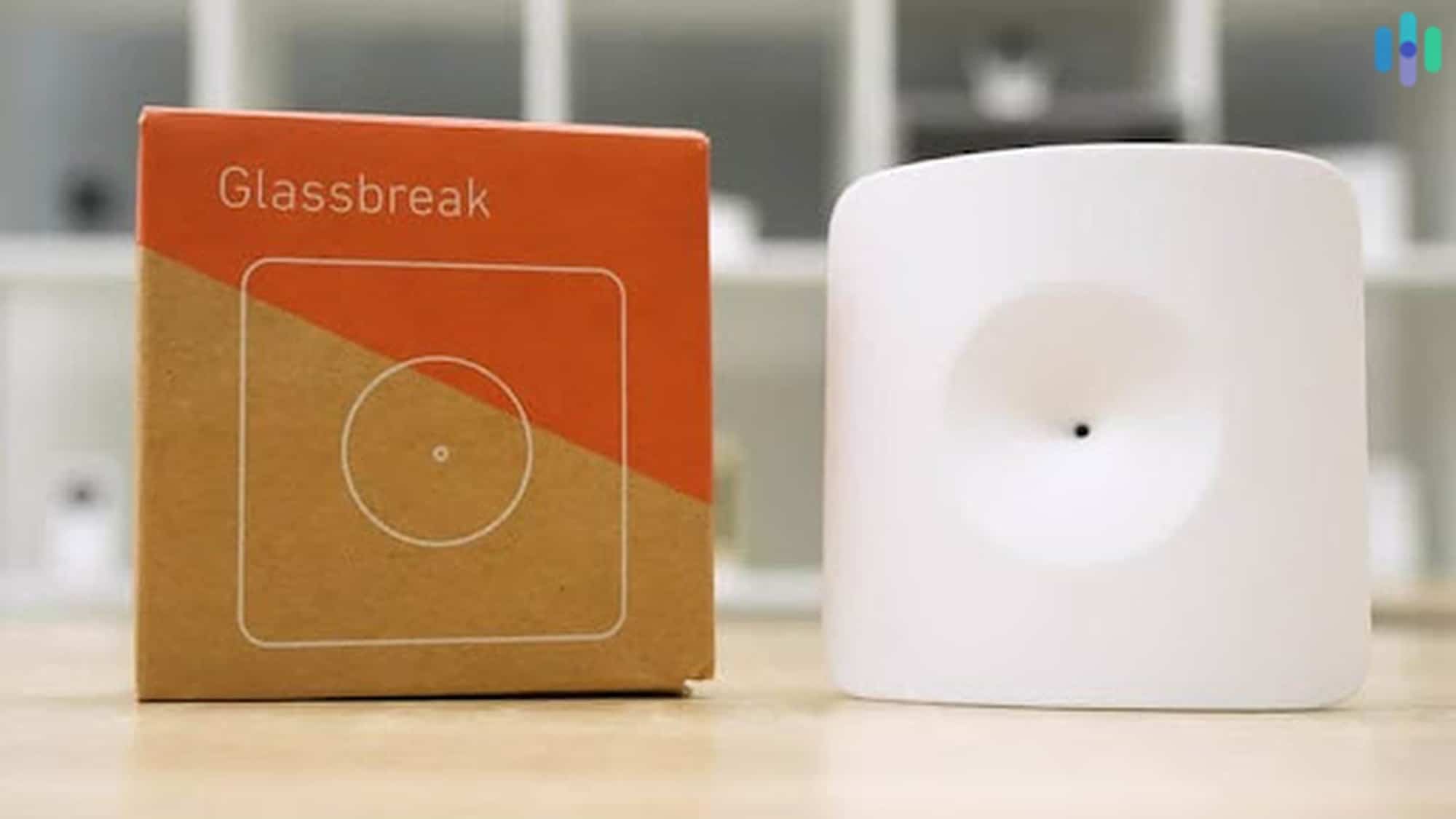
Getting the Right Glass-Break Detector
Many of the best home security systems offer packages that include glass-break detectors. You can find out which companies offer the best packages by checking out our home security system guide. Often, though, security companies sell detectors a la carte, so you can customize your home security by buying only what you need.
| Home security company | Pricing page | Acoustic glass-break detector price | Shock glass-break detector price |
|---|---|---|---|
| abode review | abode pricing | $49.99 | $39.99 |
| Ring Alarm review | Ring pricing | $39.99 | N/A |
| Cove review | Cove pricing | $35 | N/A |
| Frontpoint review | Frontpoint pricing | $74.99 | N/A |
| Link Interactive review | Link Interactive pricing | $69 | N/A |
| Simplisafe review | Simplisafe pricing | $39.99 | N/A |
| Scout Alarm review | Scout Alarm pricing | $50 | N/A |
There are a number of elements to consider when deciding which glass-break sensor is right for you:
- Sensor range: An acoustic sensor’s range determines how many windows you can protect at once. Good detectors work from 20 to 25 feet away and can respond to sounds in a 360-degree radius.
- Sensitivity: When it comes to sensitivity, you’ll want to consider whether your detector can pick up glass breaking, even if the sound is muffled. At the same time, think about how prone the sensor is to false alarms. You don’t want a unit that’s going to go off every time you propose a toast.
- Indicators: Indicators can let you know the sensor’s status, which can be helpful when you’re going out or heading to bed. The best sensors tell you not only whether the sensor is armed but also whether it’s been tampered with, how good the Wi-Fi connection is, and the state of the battery.
- Circuitry: Not all glass-break detectors have the same amount of brainpower. Pay close attention to how well the sensor can distinguish between different sounds or different kinds of vibrations.
- Alarm system compatibility: If you buy all your components from the same company, compatibility won’t be a problem. If you’re buying them separately, though, you’ll want to make sure your glass-break sensors work with your smart lights, cameras, and everything else in your security system.
- App: Look for glass-break sensors that not only detect breaking glass but will send an alert to your mobile device if they do. You want to stay on top of your home security no matter where you might be. Learn more about how to secure your home while you’re away.
- Smart home integration: If you’re building a smart home, you want one of the best security systems for Google or of the best security systems for Alexa. That includes glass-break detectors. Choose a detector that integrates well with your particular system. That way you can arm your system with simple voice commands.
- Price: For most of us, price matters. Glass-break detectors can range in price from $35 to $70. We’ve seen them go under $20 during sales though.
Installing Glass-Break Detectors
When it comes to installing your glass-break detectors, there are several factors you’ll want to consider.
Where to Place Glass-Break Detectors
You should place acoustic glass-break detectors:
- On the ground floor or basement level first
- Within a 20-foot radius of the windows that they’re supposed to protect
- Away from the walls that have the windows
- Within a clear line of sight to windows
For shock glass-break detectors, we install one per ground floor window and one on any easily accessible second-floor window. As an example, we would install a shock glass-break detector on a second-floor window if we had a porch on the other side of it.
Pro Tip: Acoustic glass-break detectors can’t work through walls. Physical objects between the sensors and windows distort the sound so sensors can’t detect it.
Installing Acoustic Glass-Break Sensors
If you choose a DIY home security system instead of one with professional installation, you’ll be responsible for installing it yourself. Some acoustic sensors sit nicely in a corner or on an end table.
If you need to install your sensor on the wall or ceiling, however, there are two basic methods. The sensor may come with a stick-up adhesive. If so, you should follow these instructions:
- Decide where you want to place the sensor.
- Using a pencil, mark the spot where you plan to place the sensor.
- Remove the adhesive protection.
- Stick the sensor on the mark you made.
If your sensor doesn’t have an adhesive, it will include a base that you screw into the ceiling or wall, normally. To install it:
- Choose a place to put the sensor.
- Mark the place where you’re planning to place the sensor with a pencil.
- Remove the sensor from its base.
- Use screws to attach the base to the ceiling or the wall.
- Reconnect the sensor to the base.
Installing Shock Glass-Break Sensors
You install all shock sensors using adhesives. To do this:
- Remove the adhesive protection from the bottom of the sensor.
- Place the sensor in the bottom corner of the window.
- Repeat the process for every window.
Adjusting Glass-Break Sensors’ Sensitivity
Once you’ve installed your glass-break detector, you should activate it and link it to your home security system and smart home devices.
It’s important to test the unit to make sure it is set to the proper sensitivity level. If the level is set too low, the sensor won’t detect breaking glass properly. If the level is set too high, the sensor will be prone to false alarms. To test your device:
- Put the device in “test” mode. Some sensors have a “test” mode to use when testing sensitivity so you do not set off the alarm. If your device has a test mode, turn it on before you begin.
- Test to make sure it detects breaking glass. Test if the unit is picking up the sound of breaking glass by actually breaking glass. Or, you can use a number of apps and YouTube videos created just for this purpose. Some glass-break detector manufacturers offer their own apps, but you can also download the Glass Break Simulator app from Google Play or Glass Break at the App Store. Make sure you’re within 20 feet of the detector when you play the test sound.
- Test to make sure it only detects breaking glass. Likewise, you can download apps that simulate other home noises to test whether your detector’s sensitivity is too high. However, in this case, you may find it more useful to test the sensor by generating actual sounds in your home. For example, try slamming doors to rattle windows. You might also clink drinking glasses to see if this triggers the alarm. And check to see if your TV can set off the detector.
Maintaining Glass-Break Sensors
Assuming you’ve set the sensitivity of your device to an appropriate level, maintenance is routine.
- Dust the detector. Dust can interfere with the sensor’s components, so wipe the detector off with a clean, dry cloth at least once every two months.
- Change the batteries. Many detectors have indicator lights to let you know when their batteries are running low. Others chirp like smoke alarms. One way or another, it’s a good idea to change out your batteries once a year.
Recap
Glass-break detectors might not be the first security device you think of when you’re outfitting your home. However, they provide extra safety barriers, working side by side with your security cameras, door sensors, and motion sensors. If you haven’t installed these handy devices in your home already, it’s time to get started.
FAQs
Read on to find even more answers to your questions about glass-break detectors.
-
Are glass-break detectors effective?
Glass-break detectors are effective tools for protecting your home. Both shock and acoustic detectors alert you if a burglar tries to break the glass in your doors or windows.
While window contact sensors can tell you if a burglar tries to raise a window, they don’t work if the thief instead breaks the window’s glass. Motion detectors can be effective, too, but only once an intruder is already inside your house. In contrast, glass-break detectors notify you when someone is trying to get in before they succeed.
-
What can trigger a glass-break alarm?
Breaking glass should trigger a glass-break alarm. However, if your acoustic detector’s sensitivity levels are set too high, you may also get alerts for other reasons, including:
- Rattling glass
- Breaking a drinking glass
- Television noises
You can get false alerts from shock sensors as well. The following actions sometimes cause false alarms:
- Slamming doors
- Roaring thunder
-
How do you test an acoustic glass-break sensor?
The best way to test a glass-break sensor is by using an app designed to simulate breaking glass. To test your sensor:
- Download a glass-breaking app or pull up a YouTube video that features the sound of breaking glass.
- Set your detector to “test” mode, if it has one.
- Play the sound of breaking glass within 20 feet of your detector to make sure it recognizes it.
- Simulate some common sounds in your house. Slam doors to rattle the windows. Play the sound of glass breaking on your television. Clink drinking glasses together.
- Adjust the sensitivity levels as necessary.
-
Do acoustic glass-break detectors work through walls?
No, acoustic glass-break detectors do not work through walls. Typically, glass-break detectors pick up sound in a 360-degree radius of 20 to 25 feet. However, walls distort a sound’s specific frequency, so even if the detector “hears” the sound of breaking glass, it won’t interpret the sound as breaking glass. In fact, you should make sure there is a direct line of sight between your detector and windows so sound waves can travel unimpeded.
-
Should I get an acoustic or vibration glass-break sensor?
Acoustic glass-break sensors are more expensive but they work for multiple windows. Shock glass-break sensors are less expensive but they only work for one window. We suggest an acoustic glass-break sensor for rooms with three or more windows and shock glass-break sensors for rooms with one or two windows.
